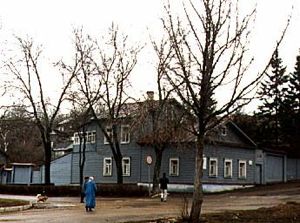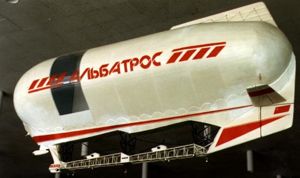
Home - Search - Browse - Alphabetic Index: 0- 1- 2- 3- 4- 5- 6- 7- 8- 9
A- B- C- D- E- F- G- H- I- J- K- L- M- N- O- P- Q- R- S- T- U- V- W- X- Y- Z
The Foundations of the Space Age
 Tsiolkovsky's house Tsiolkovsky's house in Kaluga Credit: © Mark Wade |
by Vladimir V. Lytkin
KONSTANTIN TSIOLKOVSKY - THE PIONEER OF SPACE TRAVEL
Konstantin Eduardovich Tsiolkovsky ( 1857 - 1935 ) is typically portrayed as a lone genius who worked largely in isolation from centres of higher learning and industry. An attack of scarlet fever at age ten ruined his hearing and cut off Tsiolkovsky from a normal education and social development.
However, by reading all the books in the library of his father, a forester, Tsiolkovsky managed to partially self-educate himself. In 1873, when he was 16, he went to Moscow to continue this process. In Moscow he started to dream about the possibility of space travel and interplanetary flight.
After coming back to his father's home in 1876, he worked for three years as an apprentice teacher of mathematics, physics, and chemistry. In 1879 he passed his examinations to qualify as a schoolteacher. He lived in Borovsk, Kaluga Province (1880 - 1892 ) and then in Kaluga ( 1892 - 1935 ). He continued working as as a teacher until 1921.
While living in Ryazan with his father's family, he published his first known scientific work "Astronomical Drawings" in 1879. It schematically depicted the Solar System and the distances between planets. This, his first work, already reflected his interest in the problems of space studies.
Later, in Borovsk, Tsiolkovsky wrote "Free Space" (1883). Here he considered the possibility of living in outer space and the effects of zero gravity. For the first time Tsiolkovsky included a drawing of a spacecraft that could orient itself in space with the help of reactive jets (but not change its position by propulsive rockets). It was very important for Tsiolkovsky to prove the possibility of controlled motion of an artificial vehicle in free space.
In 1903 he published an article "The Investigation of Space by Means of Reactive Devices". Here he first outlined his theory of spaceflight and published the basic equation for reaching space by rocket that is still known to students as the "Tsiolkovsky Equation". It was the first theoretical proof of the possibility of spaceflight. Over the next three decades he further developed his ideas on rocketry and space travel, publishing, along with numerous papers and monographs, a science fiction novel, for popularisation of his ideas.
In his articles he describes how space rockets would be built, and the main future principles of rocketry and space exploration. Let us mention some of them :
1. Space rockets have to use liquid engines using two components: fuel and oxidiser. The best combination would be hydrogen and oxygen, but the most useful combination would be kerosene and oxygen. It would eventually be possible to design a nuclear engine.
2. Different ways of guiding space rockets would be developed. Easiest would be to use a graphite rudder in the rocket's propulsive jet. Another possibility would be to correct the direction of the space rocket by moving all of the engine or it nozzle.
3. Gyroscope systems would be used to control the orientation of the rocket in space.
4. It would be possible to regulate the temperature inside of space rockets with the help of special outer coverings with differing the solar reflectivity.
5. For making spacewalks, extra vehicular activity would require the design of special pressure suits and air locks. Outside the space rocket, cosmonauts would work tethered to the rockets with the cords.
6. Tsiolkovsky described the effects of living under zero gravity in space rockets, and considered possible ways of protecting cosmonauts from the high gravity forces of powered flight and return to earth.
7. Among the most interesting ideas of Tsiolkovsky was the construction of long duration near-Earth (and than interplanetary) space stations. Later it would be possible to design and build "Space Islands" - huge habitats for thousands of people.
8. In 1926 Tsiolkovsky wrote his well known "Plan Of Space Exploration" (this saw manned colonization of the universe in 16 stages).
9. Tsiolkovsky suggested design of special launch ramps for space rockets - using a special ramp booster as the first stage of space rocket.
10. In 1929 Tsiolkovsky wrote and published his work "Rocket Space Trains". He suggested a method of reaching of escape velocity using a multistage booster, consisting of separate rockets joined together and launched simultaneously. These very last calculations about multistage boosters pushed Tsiolkovsky to the conclusion that the first space flights would take place within 20 to 30 years. He made this prediction during his last radiio speech from Moscow on May 1, 1932.
These were the tremendous visions of the great thinker and scientist Tsiolkovsky, who called himself "The Citizen of the Universe".
APPENDIX
Konstantin E. Tsiolkovsky's 16 Stages of Space Exploration.
( 1926 )
1. Design of rocket-propelled airplanes with wings.
2. Progressively increasing the speeds and altitudes reached with these airplanes.
3. Designing of a pure rocket without wings.
4. Developing the ability to land on the ocean surface by rocket.
5. Reaching of escape velocity and first flight into space.
6. Lengthening of the rocket flight time into space.
7. Experimental use of plants to make an artificial atmosphere in spacecraft.
8. Using of pressurised space suits for activity outside spacecraft.
9. Making of orbital greenhouses for plants.
10. Building of the large orbital habitats around the earth.
11. Using solar radiation to grow food, to heat space quarters, and for transport needs throughout the solar system.
12. Colonization of the asteroid belt.
13. Colonisation of the entire solar system and beyond.
14. Achievement of individual and social perfection.
15. Overcrowding of the solar system and galaxy colonisation.
16. The sun begins to die and the people remaining in the solar system's population move to other solar systems.
BIBLIOGRAPHY
1. Bainbridge, William S.,1983. The Spaceflight Revolution. Krieger, Malabar, Florida.
2. Kosmodemyansky, Arkady A., 1987. Konstantin Eduardovich Tsiolkovsky (in Russian). Nauka,Moscow.
3. Rynin, Nikolay A., 1931. K.E.Tsiolkovsky : Life, Writings and Rockets. Vol.3, No.7 of Interplanetary Flight and Communication. Leningrad. Translated in Jerusalem, 1971.
4. Rynin, Nikolay A., 1932. Theory of Space Flight. Vol.3, No.8. (the same ed.)
5. Samoilovitch, Sergei I., 1969. Citizen of the Universe (in Russian), Tsiolkovsky State Museum of the History of Cosmonautics, Kaluga.
6. Tsiolkovsky, Konstantin E., 1995. Exploration of the Universe with Reaction Machines : Exploring the Unknoun. The NASA History Series. NASA SP 4407, Washington, D.C.
 | Tsiolkovsky rocket Tsiolkovsky's manned rocket design Credit: © Mark Wade |
 | Tsiolkovsky rocket Tsiolkovsky's manned rocket design Credit: © Mark Wade |
 | Tsiolkovsky ship Detail of crew levels of Tsiolkovsky's manned rocket design Credit: © Mark Wade |
 | Albatros aerostat Tsiolkovsky's Albatros aerostat concept Credit: © Mark Wade |
Back to top of page
Home - Search - Browse - Alphabetic Index: 0- 1- 2- 3- 4- 5- 6- 7- 8- 9
A- B- C- D- E- F- G- H- I- J- K- L- M- N- O- P- Q- R- S- T- U- V- W- X- Y- Z
© 1997-2019 Mark Wade - Contact
© / Conditions for Use